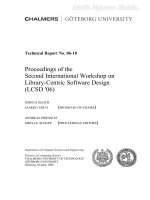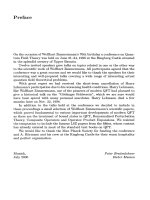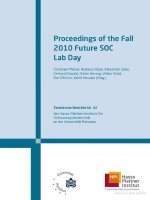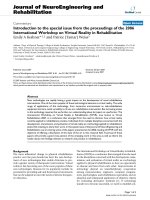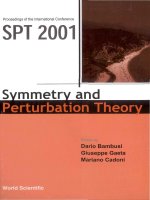Proceedings of the linux
Bạn đang xem bản rút gọn của tài liệu. Xem và tải ngay bản đầy đủ của tài liệu tại đây (5.83 MB, 314 trang )
Proceedings of the
Linux Symposium
Volume One
June 27th–30th, 2007
Ottawa, Ontario
Canada
Contents
The Price of Safety: Evaluating IOMMU Performance 9
Ben-Yehuda, Xenidis, Mostrows, Rister, Bruemmer, Van Doorn
Linux on Cell Broadband Engine status update 21
Arnd Bergmann
Linux Kernel Debugging on Google-sized clusters 29
M. Bligh, M. Desnoyers, & R. Schultz
Ltrace Internals 41
Rodrigo Rubira Branco
Evaluating effects of cache memory compression on embedded systems 53
Anderson Briglia, Allan Bezerra, Leonid Moiseichuk, & Nitin Gupta
ACPI in Linux – Myths vs. Reality 65
Len Brown
Cool Hand Linux – Handheld Thermal Extensions 75
Len Brown
Asynchronous System Calls 81
Zach Brown
Frysk 1, Kernel 0? 87
Andrew Cagney
Keeping Kernel Performance from Regressions 93
T. Chen, L. Ananiev, and A. Tikhonov
Breaking the Chains—Using LinuxBIOS to Liberate Embedded x86 Processors 103
J. Crouse, M. Jones, & R. Minnich
GANESHA, a multi-usage with large cache NFSv4 server 113
P. Deniel, T. Leibovici, & J C. Lafoucrière
Why Virtualization Fragmentation Sucks 125
Justin M. Forbes
A New Network File System is Born: Comparison of SMB2, CIFS, and NFS 131
Steven French
Supporting the Allocation of Large Contiguous Regions of Memory 141
Mel Gorman
Kernel Scalability—Expanding the Horizon Beyond Fine Grain Locks 153
Corey Gough, Suresh Siddha, & Ken Chen
Kdump: Smarter, Easier, Trustier 167
Vivek Goyal
Using KVM to run Xen guests without Xen 179
R.A. Harper, A.N. Aliguori & M.D. Day
Djprobe—Kernel probing with the smallest overhead 189
M. Hiramatsu and S. Oshima
Desktop integration of Bluetooth 201
Marcel Holtmann
How virtualization makes power management different 205
Yu Ke
Ptrace, Utrace, Uprobes: Lightweight, Dynamic Tracing of User Apps 215
J. Keniston, A. Mavinakayanahalli, P. Panchamukhi, & V. Prasad
kvm: the Linux Virtual Machine Monitor 225
A. Kivity, Y. Kamay, D. Laor, U. Lublin, & A. Liguori
Linux Telephony 231
Paul P. Komkoff, A. Anikina, & R. Zhnichkov
Linux Kernel Development 239
Greg Kroah-Hartman
Implementing Democracy 245
Christopher James Lahey
Extreme High Performance Computing or Why Microkernels Suck 251
Christoph Lameter
Performance and Availability Characterization for Linux Servers 263
Linkov Koryakovskiy
“Turning the Page” on Hugetlb Interfaces 277
Adam G. Litke
Resource Management: Beancounters 285
Pavel Emelianov, Denis Lunev and Kirill Korotaev
Manageable Virtual Appliances 293
D. Lutterkort
Everything is a virtual filesystem: libferris 303
Ben Martin
Conference Organizers
Andrew J. Hutton, Steamballoon, Inc., Linux Symposium,
Thin Lines Mountaineering
C. Craig Ross, Linux Symposium
Review Committee
Andrew J. Hutton, Steamballoon, Inc., Linux Symposium,
Thin Lines Mountaineering
Dirk Hohndel, Intel
Martin Bligh, Google
Gerrit Huizenga, IBM
Dave Jones, Red Hat, Inc.
C. Craig Ross, Linux Symposium
Proceedings Formatting Team
John W. Lockhart, Red Hat, Inc.
Gurhan Ozen, Red Hat, Inc.
John Feeney, Red Hat, Inc.
Len DiMaggio, Red Hat, Inc.
John Poelstra, Red Hat, Inc.
Authors retain copyright to all submitted papers, but have granted unlimited redistribution rights
to all as a condition of submission.
The Price of Safety: Evaluating IOMMU Performance
Muli Ben-Yehuda
IBM Haifa Research Lab
Jimi Xenidis
IBM Research
Michal Ostrowski
IBM Research
Karl Rister
IBM LTC
Alexis Bruemmer
IBM LTC
Leendert Van Doorn
AMD
Abstract
IOMMUs, IO Memory Management Units, are hard-
ware devices that translate device DMA addresses to
machine addresses. An isolation capable IOMMU re-
stricts a device so that it can only access parts of mem-
ory it has been explicitly granted access to. Isolation
capable IOMMUs perform a valuable system service by
preventing rogue devices from performing errant or ma-
licious DMAs, thereby substantially increasing the sys-
tem’s reliability and availability. Without an IOMMU
a peripheral device could be programmed to overwrite
any part of the system’s memory. Operating systems uti-
lize IOMMUs to isolate device drivers; hypervisors uti-
lize IOMMUs to grant secure direct hardware access to
virtual machines. With the imminent publication of the
PCI-SIG’s IO Virtualization standard, as well as Intel
and AMD’s introduction of isolation capable IOMMUs
in all new servers, IOMMUs will become ubiquitous.
Although they provide valuable services, IOMMUs can
impose a performance penalty due to the extra memory
accesses required to perform DMA operations. The ex-
act performance degradation depends on the IOMMU
design, its caching architecture, the way it is pro-
grammed and the workload. This paper presents the
performance characteristics of the Calgary and DART
IOMMUs in Linux, both on bare metal and in a hyper-
visor environment. The throughput and CPU utilization
of several IO workloads, with and without an IOMMU,
are measured and the results are analyzed. The poten-
tial strategies for mitigating the IOMMU’s costs are then
discussed. In conclusion a set of optimizations and re-
sulting performance improvements are presented.
1 Introduction
An I/O Memory Management Unit (IOMMU) creates
one or more unique address spaces which can be used
to control how a DMA operation, initiated by a device,
accesses host memory. This functionality was originally
introduced to increase the addressability of a device or
bus, particularly when 64-bit host CPUs were being in-
troduced while most devices were designed to operate
in a 32-bit world. The uses of IOMMUs were later ex-
tended to restrict the host memory pages that a device
can actually access, thus providing an increased level of
isolation, protecting the system from user-level device
drivers and eventually virtual machines. Unfortunately,
this additional logic does impose a performance penalty.
The wide spread introduction of IOMMUs by Intel [1]
and AMD [2] and the proliferation of virtual machines
will make IOMMUs a part of nearly every computer
system. There is no doubt with regards to the benefits
IOMMUs bring. but how much do they cost? We seek
to quantify, analyze, and eventually overcome the per-
formance penalties inherent in the introduction of this
new technology.
1.1 IOMMU design
A broad description of current and future IOMMU
hardware and software designs from various companies
can be found in the OLS ’06 paper entitled Utilizing
IOMMUs for Virtualization in Linux and Xen [3]. The
design of a system with an IOMMU can be broadly bro-
ken down into the following areas:
• IOMMU hardware architecture and design.
• Hardware ↔ software interfaces.
• 9 •
10 • The Price of Safety: Evaluating IOMMU Performance
• Pure software interfaces (e.g., between userspace
and kernelspace or between kernelspace and hyper-
visor).
It should be noted that these areas can and do affect each
other: the hardware/software interface can dictate some
aspects of the pure software interfaces, and the hardware
design dictates certain aspects of the hardware/software
interfaces.
This paper focuses on two different implementations
of the same IOMMU architecture that revolves around
the basic concept of a Translation Control Entry (TCE).
TCEs are described in detail in Section 1.1.2.
1.1.1 IOMMU hardware architecture and design
Just as a CPU-MMU requires a TLB with a very high
hit-rate in order to not impose an undue burden on the
system, so does an IOMMU require a translation cache
to avoid excessive memory lookups. These translation
caches are commonly referred to as IOTLBs.
The performance of the system is affected by several
cache-related factors:
• The cache size and associativity [13].
• The cache replacement policy.
• The cache invalidation mechanism and the fre-
quency and cost of invalidations.
The optimal cache replacement policy for an IOTLB
is probably significantly different than for an MMU-
TLB. MMU-TLBs rely on spatial and temporal locality
to achieve a very high hit-rate. DMA addresses from de-
vices, however, do not necessarily have temporal or spa-
tial locality. Consider for example a NIC which DMAs
received packets directly into application buffers: pack-
ets for many applications could arrive in any order and at
any time, leading to DMAs to wildly disparate buffers.
This is in sharp contrast with the way applications ac-
cess their memory, where both spatial and temporal lo-
cality can be observed: memory accesses to nearby ar-
eas tend to occur closely together.
Cache invalidation can have an adverse effect on the
performance of the system. For example, the Calgary
IOMMU (which will be discussed later in detail) does
not provide a software mechanism for invalidating a sin-
gle cache entry—one must flush the entire cache to in-
validate an entry. We present a related optimization in
Section 4.
It should be mentioned that the PCI-SIG IOV (IO Vir-
tualization) working group is working on an Address
Translation Services (ATS) standard. ATS brings in an-
other level of caching, by defining how I/O endpoints
(i.e., adapters) inter-operate with the IOMMU to cache
translations on the adapter and communicate invalida-
tion requests from the IOMMU to the adapter. This adds
another level of complexity to the system, which needs
to be overcome in order to find the optimal caching strat-
egy.
1.1.2 Hardware ↔ Software Interface
The main hardware/software interface in the TCE fam-
ily of IOMMUs is the Translation Control Entry (TCE).
TCEs are organized in TCE tables. TCE tables are anal-
ogous to page tables in an MMU, and TCEs are similar
to page table entries (PTEs). Each TCE identifies a 4KB
page of host memory and the access rights that the bus
(or device) has to that page. The TCEs are arranged in
a contiguous series of host memory pages that comprise
the TCE table. The TCE table creates a single unique IO
address space (DMA address space) for all the devices
that share it.
The translation from a DMA address to a host mem-
ory address occurs by computing an index into the TCE
table by simply extracting the page number from the
DMA address. The index is used to compute a direct
offset into the TCE table that results in a TCE that trans-
lates that IO page. The access control bits are then used
to validate both the translation and the access rights to
the host memory page. Finally, the translation is used by
the bus to direct a DMA transaction to a specific location
in host memory. This process is illustrated in Figure 1.
The TCE architecture can be customized in several
ways, resulting in different implementations that are op-
timized for a specific machine. This paper examines the
performance of two TCE implementations. The first one
is the Calgary family of IOMMUs, which can be found
in IBM’s high-end System x (x86-64 based) servers, and
the second one is the DMA Address Relocation Table
(DART) IOMMU, which is often paired with PowerPC
2007 Linux Symposium, Volume One • 11
ByteIO Page Number
IO Address
Control
Real Page Number
Access
PN1
Control
Real Page Number
Access
PN2
Access
PNn
Control
Control
Real Page Number
Access
PN0
TCE Table
Real Page Number Byte
Host Memory Address
Real Page Number
Figure 1: TCE table
970 processors that can be found in Apple G5 and IBM
JS2x blades, as implemented by the CPC945 Bridge and
Memory Controller.
The format of the TCEs are the first level of customiza-
tion. Calgary is designed to be integrated with a Host
Bridge Adapter or South Bridge that can be paired with
several architectures—in particular ones with a huge ad-
dressable range. The Calgary TCE has the following
format:
The 36 bits of RPN represent a generous 48 bits (256
TB) of addressability in host memory. On the other
hand, the DART, which is integrated with the North
Bridge of the Power970 system, can take advantage of
the systems maximum 24-bit RPN for 36-bits (64 GB)
of addressability and reduce the TCE size to 4 bytes, as
shown in Table 2.
This allows DART to reduce the size of the table by half
for the same size of IO address space, leading to bet-
ter (smaller) host memory consumption and better host
Bits Field Description
0:15 Unused
16:51 RPN Real Page number
52:55 Reserved
56:61 Hub ID
Used when a single TCE table
isolates several busses
62 W* W=1 ⇒ Write allowed
63 R* R=1 ⇒ Read allowed
*R=0 and W=0 represent an invalid translation
Table 1: Calgary TCE format
cache utilization.
1.1.3 Pure Software Interfaces
The IOMMU is a shared hardware resource, which is
used by drivers, which could be implemented in user-
space, kernel-space, or hypervisor-mode. Hence the
IOMMU needs to be owned, multiplexed and protected
12 • The Price of Safety: Evaluating IOMMU Performance
Bits Field Description
0 Valid 1 - valid
1 R R=0 ⇒ Read allowed
2 W W=0 ⇒ Write allowed
3:7 Reserved
8:31 RPN Real Page Number
Table 2: DART TCE format
by system software—typically, an operating system or
hypervisor.
In the bare-metal (no hypervisor) case, without any
userspace driver, with Linux as the operating system, the
relevant interface is Linux’s DMA-API [4][5]. In-kernel
drivers call into the DMA-API to establish and tear-
down IOMMU mappings, and the IOMMU’s DMA-
API implementation maps and unmaps pages in the
IOMMU’s tables. Further details on this API and the
Calgary implementation thereof are provided in the OLS
’06 paper entitled Utilizing IOMMUs for Virtualization
in Linux and Xen [3].
The hypervisor case is implemented similarly, with a
hypervisor-aware IOMMU layer which makes hyper-
calls to establish and tear down IOMMU mappings. As
will be discussed in Section 4, these basic schemes can
be optimized in several ways.
It should be noted that for the hypervisor case there
is also a common alternative implementation tailored
for guest operating systems which are not aware of the
IOMMU’s existence, where the IOMMU’s mappings
are managed solely by the hypervisor without any in-
volvement of the guest operating system. This mode
of operation and its disadvantages are discussed in Sec-
tion 4.3.1.
2 Performance Results and Analysis
This section presents the performance of IOMMUs,
with and without a hypervisor. The benchmarks
were run primarily using the Calgary IOMMU, al-
though some benchmarks were also run with the DART
IOMMU. The benchmarks used were FFSB [6] for disk
IO and netperf [7] for network IO. Each benchmark was
run in two sets of runs, first with the IOMMU disabled
and then with the IOMMU enabled. The benchmarks
were run on bare-metal Linux (Calgary and DART) and
Xen dom0 and domU (Calgary).
For network tests the netperf [7] benchmark was used,
using the TCP_STREAM unidirectional bulk data trans-
fer option. The tests were run on an IBM x460 system
(with the Hurricane 2.1 chipset), using 4 x dual-core
Paxville Processors (with hyperthreading disabled). The
system had 16GB RAM, but was limited to 4GB us-
ing mem=4G for IO testing. The system was booted
and the tests were run from a QLogic 2300 Fiber Card
(PCI-X, volumes from a DS3400 hooked to a SAN). The
on-board Broadcom Gigabit Ethernet adapter was used.
The system ran SLES10 x86_64 Base, with modified
kernels and Xen.
The netperf client system was an IBM e326 system,
with 2 x 1.8 GHz Opteron CPUs and 6GB RAM. The
NIC used was the on-board Broadcom Gigabit Ethernet
adapter, and the system ran an unmodified RHEL4 U4
distribution. The two systems were connected through a
Cisco 3750 Gigabit Switch stack.
A 2.6.21-rc6 based tree with additional Calgary patches
(which are expected to be merged for 2.6.23) was
used for bare-metal testing. For Xen testing, the xen-
iommu and linux-iommu trees [8] were used. These are
IOMMU development trees which track xen-unstable
closely. xen-iommu contains the hypervisor bits and
linux-iommu contains the xenolinux (both dom0 and
domU) bits.
2.1 Results
For the sake of brevity, we present only the network re-
sults. The FFSB (disk IO) results were comparable. For
Calgary, the system was tested in the following modes:
• netperf server running on a bare-metal kernel.
• netperf server running in Xen dom0, with dom0
driving the IOMMU. This setup measures the per-
formance of the IOMMU for a “direct hardware ac-
cess” domain—a domain which controls a device
for its own use.
• netperf server running in Xen domU, with dom0
driving the IOMMU and domU using virtual-IO
(netfront or blkfront). This setup measures the per-
formance of the IOMMU for a “driver domain”
scenario, where a “driver domain” (dom0) controls
a device on behalf of another domain (domU).
2007 Linux Symposium, Volume One • 13
The first test (netperf server running on a bare-metal ker-
nel) was run for DART as well.
Each set of tests was run twice, once with the IOMMU
enabled and once with the IOMMU disabled. For each
test, the following parameters were measured or calcu-
lated: throughput with the IOMMU disabled and en-
abled (off and on, respectively), CPU utilization with
the IOMMU disabled and enabled, and the relative dif-
ference in throughput and CPU utilization. Note that
due to different setups the CPU utilization numbers are
different between bare-metal and Xen. Each CPU uti-
lization number is accompanied by the potential maxi-
mum.
For the bare-metal network tests, summarized in Fig-
ures 2 and 3, there is practically no difference between
the CPU throughput with and without an IOMMU. With
an IOMMU, however, the CPU utilization can be as
much as 60% more (!), albeit it is usually closer to 30%.
These results are for Calgary—for DART, the results are
largely the same.
For Xen, tests were run with the netperf server in dom0
as well as in domU. In both cases, dom0 was driving
the IOMMU (in the tests where the IOMMU was en-
abled). In the domU tests domU was using the virtual-
IO drivers. The dom0 tests measure the performance of
the IOMMU for a “direct hardware access” scenario and
the domU tests measure the performance of the IOMMU
for a “driver domain” scenario.
Network results for netperf server running in dom0 are
summarized in Figures 4 and 5. For messages of sizes
1024 and up, the results strongly resemble the bare-
metal case: no noticeable throughput difference except
for very small packets and 40–60% more CPU utiliza-
tion when IOMMU is enabled. For messages with sizes
of less than 1024, the throughput is significantly less
with the IOMMU enabled than it is with the IOMMU
disabled.
For Xen domU, the tests show up to 15% difference in
throughput for message sizes smaller than 512 and up to
40% more CPU utilization for larger messages. These
results are summarized in Figures 6 and 7.
3 Analysis
The results presented above tell mostly the same story:
throughput is the same, but CPU utilization rises when
the IOMMU is enabled, leading to up to 60% more CPU
utilization. The throughput difference with small net-
work message sizes in the Xen network tests probably
stems from the fact that the CPU isn’t able to keep up
with the network load when the IOMMU is enabled. In
other words, dom0’s CPU is close to the maximum even
with the IOMMU disabled, and enabling the IOMMU
pushes it over the edge.
On one hand, these results are discouraging: enabling
the IOMMU to get safety and paying up to 60% more in
CPU utilization isn’t an encouraging prospect. On the
other hand, the fact that the throughput is roughly the
same when the IOMMU code doesn’t overload the sys-
tem strongly suggests that software is the culprit, rather
than hardware. This is good, because software is easy to
fix!
Profile results from these tests strongly suggest that
mapping and unmapping an entry in the TCE table is
the biggest performance hog, possibly due to lock con-
tention on the IOMMU data structures lock. For the
bare-metal case this operation does not cross address
spaces, but it does require taking a spinlock, searching a
bitmap, modifying it, performing several arithmetic op-
erations, and returning to the user. For the hypervisor
case, these operations require all of the above, as well
as switching to hypervisor mode.
As we will see in the next section, most of the optimiza-
tions discussed are aimed at reducing both the number
and costs of TCE map and unmap requests.
4 Optimizations
This section discusses a set of optimizations that have
either already been implemented or are in the process of
being implemented. “Deferred Cache Flush” and “Xen
multicalls” were implemented during the IOMMU’s
bring-up phase and are included in the results presented
above. The rest of the optimizations are being imple-
mented and were not included in the benchmarks pre-
sented above.
4.1 Deferred Cache Flush
The Calgary IOMMU, as it is used in Intel-based
servers, does not include software facilities to invalidate
selected entries in the TCE cache (IOTLB). The only
14 • The Price of Safety: Evaluating IOMMU Performance
Figure 2: Bare-metal Network Throughput
Figure 3: Bare-metal Network CPU Utilization
2007 Linux Symposium, Volume One • 15
Figure 4: Xen dom0 Network Throughput
Figure 5: Xen dom0 Network CPU Utilization
16 • The Price of Safety: Evaluating IOMMU Performance
Figure 6: Xen domU Network Throughput
Figure 7: Xen domU Network CPU Utilization
2007 Linux Symposium, Volume One • 17
way to invalidate an entry in the TCE cache is to qui-
esce all DMA activity in the system, wait until all out-
standing DMAs are done, and then flush the entire TCE
cache. This is a cumbersome and lengthy procedure.
In theory, for maximal safety, one would want to inval-
idate an entry as soon as that entry is unmapped by the
driver. This will allow the system to catch any “use after
free” errors. However, flushing the entire cache after ev-
ery unmap operation proved prohibitive—it brought the
system to its knees. Instead, the implementation trades
a little bit of safety for a whole lot of usability. Entries
in the TCE table are allocated using a next-fit allocator,
and the cache is only flushed when the allocator rolls
around (starts to allocate from the beginning). This op-
timization is based on the observation that an entry only
needs to be invalidated before it is re-used. Since a given
entry will only be reused once the allocator rolls around,
roll-around is the point where the cache must be flushed.
The downside to this optimization is that it is possible
for a driver to reuse an entry after it has unmapped it,
if that entry happened to remain in the TCE cache. Un-
fortunately, closing this hole by invalidating every entry
immediately when it is freed, cannot be done with the
current generation of the hardware. The hole has never
been observed to occur in practice.
This optimization is applicable to both bare-metal and
hypervisor scenarios.
4.2 Xen multicalls
The Xen hypervisor supports “multicalls” [12]. A mul-
ticall is a single hypercall that includes the parameters
of several distinct logical hypercalls. Using multicalls
it is possible to reduce the number of hypercalls needed
to perform a sequence of operations, thereby reducing
the number of address space crossings, which are fairly
expensive.
The Calgary Xen implementation uses multicalls to
communicate map and unmap requests from a domain
to the hypervisor. Unfortunately, profiling has shown
that the vast majority of map and unmap requests (over
99%) are for a single entry, making multicalls pointless.
This optimization is only applicable to hypervisor sce-
narios.
4.3 Overhauling the DMA API
Profiling of the above mentioned benchmarks shows that
the number one culprits for CPU utilization are the map
and unmap calls. There are several ways to cut down on
the overhead of map and unmap calls:
• Get rid of them completely.
• Allocate in advance; free when done.
• Allocate and free in large batches.
• Never free.
4.3.1 Using Pre-allocation to Get Rid of Map and
Unmap
Calgary provides somewhat less than a 4GB DMA ad-
dress space (exactly how much less depends on the sys-
tem’s configuration). If the guest’s pseudo-physical ad-
dress space fits within the DMA address space, one pos-
sible optimization is to only allocate TCEs when the
guest starts up and free them when the guest shuts down.
The TCEs are allocated such that TCE i maps the same
machine frame as the guest’s pseudo-physical address
i. Then the guest could pretend that it doesn’t have an
IOMMU and pass the pseudo-physical address directly
to the device. No cache flushes are necessary because
no entry is ever invalidated.
This optimization, while appealing, has several down-
sides: first and foremost, it is only applicable to a hy-
pervisor scenario. In a bare-metal scenario, getting rid
of map and unmap isn’t practical because it renders the
IOMMU useless—if one maps all of physical memory,
why use an IOMMU at all? Second, even in a hyper-
visor scenario, pre-allocation is only viable if the set
of machine frames owned by the guest is “mostly con-
stant” through the guest’s lifetime. If the guest wishes to
use page flipping or ballooning, or any other operation
which modifies the guest’s pseudo-physical to machine
mapping, the IOMMU mapping needs to be updated as
well so that the IO to machine mapping will again cor-
respond exactly to the pseudo-physical to machine map-
ping. Another downside of this optimization is that it
protects other guests and the hypervisor from the guest,
but provides no protection inside the guest itself.
18 • The Price of Safety: Evaluating IOMMU Performance
4.3.2 Allocate In Advance And Free When Done
This optimization is fairly simple: rather than using the
“streaming” DMA API operations, use the alloc and free
operations to allocate and free DMA buffers and then
use them for as long as possible. Unfortunately this re-
quires a massive change to the Linux kernel since driver
writers have been taught since the days of yore that
DMA mappings are a sparse resource and should only
be allocated when absolutely needed. A better way to
do this might be to add a caching layer inside the DMA
API for platforms with many DMA mappings so that
driver writers could still use the map and unmap API,
but the actual mapping and unmapping will only take
place the first time a frame is mapped. This optimiza-
tion is applicable to both bare-metal and hypervisors.
4.3.3 Allocate And Free In Large Batches
This optimization is a twist on the previous one: rather
than modifying drivers to use alloc and free rather than
map and unmap, use map_multi and unmap_multi wher-
ever possible to batch the map and unmap operations.
Again, this optimization requires fairly large changes
to the drivers and subsystems and is applicable to both
bare-metal and hypervisor scenarios.
4.3.4 Never Free
One could sacrifice some of the protection afforded by
the IOMMU for the sake of performance by simply
never unmapping entries from the TCE table. This will
reduce the cost of unmap operations (but not eliminate
it completely—one would still need to know which en-
tries are mapped and which have been theoretically “un-
mapped” and could be reused) and will have a particu-
larly large effect on the performance of hypervisor sce-
narios. However, it will sacrifice a large portion of
the IOMMU’s advantage: any errant DMA to an ad-
dress that corresponds with a previously mapped and
unmapped entry will go through, causing memory cor-
ruption.
4.4 Grant Table Integration
This work has mostly been concerned with “direct hard-
ware access” domains which have direct access to hard-
ware devices. A subset of such domains are Xen “driver
domains” [11], which use direct hardware access to per-
form IO on behalf of other domains. For such “driver
domains,” using Xen’s grant table interface to pre-map
TCE entries as part of the grant operation will save
an address space crossing to map the TCE through the
DMA API later. This optimization is only applicable to
hypervisor (specifically, Xen) scenarios.
5 Future Work
Avenues for future exploration include support and per-
formance evaluation for more IOMMUs such as Intel’s
VT-d [1] and AMD’s IOMMU [2], completing the im-
plementations of the various optimizations that have
been presented in this paper and studying their effects
on performance, coming up with other optimizations
and ultimately gaining a better understanding of how to
build “zero-cost” IOMMUs.
6 Conclusions
The performance of two IOMMUs, DART on PowerPC
and Calgary on x86-64, was presented, through running
IO-intensive benchmarks with and without an IOMMU
on the IO path. In the common case throughput re-
mained the same whether the IOMMU was enabled or
disabled. CPU utilization, however, could be as much as
60% more in a hypervisor environment and 30% more
in a bare-metal environment, when the IOMMU was en-
abled.
The main CPU utilization cost came from too-frequent
map and unmap calls (used to create translation entries
in the DMA address space). Several optimizations were
presented to mitigate that cost, mostly by batching map
and unmap calls in different levels or getting rid of them
entirely where possible. Analyzing the feasibility of
each optimization and the savings it produces is a work
in progress.
Acknowledgments
The authors would like to thank Jose Renato Santos
and Yoshio Turner for their illuminating comments and
questions on an earlier draft of this manuscript.
2007 Linux Symposium, Volume One • 19
References
[1] Intel Virtualization Technology for Directed I/O
Architecture Specification, 2006,
/>technology/computing/vptech/
Intel(r)_VT_for_Direct_IO.pdf.
[2] AMD I/O Virtualization Technology (IOMMU)
Specification, 2006, />us-en/assets/content_type/white_
papers_and_tech_docs/34434.pdf.
[3] Utilizing IOMMUs for Virtualization in Linux and
Xen, by M. Ben-Yehuda, J. Mason, O. Krieger,
J. Xenidis, L. Van Doorn, A. Mallick,
J. Nakajima, and E. Wahlig, in Proceedings of the
2006 Ottawa Linux Symposium (OLS), 2006.
[4] Documentation/DMA-API.txt.
[5] Documentation/DMA-mapping.txt.
[6] Flexible Filesystem Benchmark (FFSB) http:
//sourceforge.net/projects/ffsb/
[7] Netperf Benchmark
[8] Xen IOMMU trees, 2007, http://xenbits.
xensource.com/ext/xen-iommu.hg,
/>linux-iommu.hg
[9] Xen and the Art of Virtualization, by B. Dragovic,
K. Fraser, S. Hand, T. Harris, A. Ho, I. Pratt,
A. Warfield, P. Barham, and R. Neugebauer, in
Proceedings of the 19th ASM Symposium on
Operating Systems Principles (SOSP), 2003.
[10] Xen 3.0 and the Art of Virtualization, by I. Pratt,
K. Fraser, S. Hand, C. Limpach, A. Warfield,
D. Magenheimer, J. Nakajima, and A. Mallick, in
Proceedings of the 2005 Ottawa Linux
Symposium (OLS), 2005.
[11] Safe Hardware Access with the Xen Virtual
Machine Monitor, by K. Fraser, S. Hand,
R. Neugebauer, I. Pratt, A. Warfield,
M. Williamson, in Proceedings of the OASIS
ASPLOS 2004 workshop, 2004.
[12] Virtualization in Xen 3.0, by R. Rosen, http://
www.linuxjournal.com/article/8909
[13] Computer Architecture, Fourth Edition: A
Quantitative Approach, by J. Hennessy and
D. Patterson, Morgan Kaufmann publishers,
September, 2006.
20 • The Price of Safety: Evaluating IOMMU Performance
Linux on Cell Broadband Engine status update
Arnd Bergmann
IBM Linux Technology Center
Abstract
With Linux for the Sony PS3, the IBM QS2x blades
and the Toshiba Celleb platform having hit mainstream
Linux distributions, programming for the Cell BE is be-
coming increasingly interesting for developers of per-
formance computing. This talk is about the concepts of
the architecture and how to develop applications for it.
Most importantly, there will be an overview of new fea-
ture additions and latest developments, including:
• Preemptive scheduling on SPUs (finally!): While it
has been possible to run concurrent SPU programs
for some time, there was only a very limited ver-
sion of the scheduler implemented. Now we have
a full time-slicing scheduler with normal and real-
time priorities, SPU affinity and gang scheduling.
• Using SPUs for offloading kernel tasks: There are a
few compute intensive tasks like RAID-6 or IPsec
processing that can benefit from running partially
on an SPU. Interesting aspects of the implementa-
tion are how to balance kernel SPU threads against
user processing, how to efficiently communicate
with the SPU from the kernel and measurements
to see if it is actually worthwhile.
• Overlay programming: One significant limitation
of the SPU is the size of the local memory that is
used for both its code and data. Recent compil-
ers support overlays of code segments, a technique
widely known in the previous century but mostly
forgotten in Linux programming nowadays.
1 Background
The architecture of the Cell Broadband Engine
(Cell/B.E.) is unique in many ways. It combines a gen-
eral purpose PowerPC processor with eight highly op-
timized vector processing cores called the Synergistic
Processing Elements (SPEs) on a single chip. Despite
implementing two distinct instruction sets, they share
the design of their memory management units and can
access virtual memory in a cache-coherent way.
The Linux operating system runs on the PowerPC Pro-
cessing Element (PPE) only, not on the SPEs, but
the kernel and associated libraries allow users to run
special-purpose applications on the SPE as well, which
can interact with other applications running on the PPE.
This approach makes it possible to take advantage of the
wide range of applications available for Linux, while at
the same time utilize the performance gain provided by
the SPE design, which could not be achieved by just re-
compiling regular applications for a new architecture.
One key aspect of the SPE design is the way that mem-
ory access works. Instead of a cache memory that
speeds up memory accesses in most current designs,
data is always transferred explicitly between the lo-
cal on-chip SRAM and the virtually addressed system
memory. An SPE program resides in the local 256KiB
of memory, together with the data it is working on.
Every time it wants to work on some other data, the
SPE tells its Memory Flow Controller (MFC) to asyn-
chronously copy between the local memory and the vir-
tual address space.
The advantage of this approach is that a well-written
application practically never needs to wait for a mem-
ory access but can do all of these in the background.
The disadvantages include the limitation to 256KiB of
directly addressable memory that limit the set of appli-
cations that can be ported to the architecture, and the
relatively long time required for a context switch, which
needs to save and restore all of the local memory and
the state of ongoing memory transfers instead of just the
CPU registers.
• 21 •
22 • Linux on Cell Broadband Engine status update
Hardware
Hypervisor
libspe2
elfspe ALF
Multicore
Plus
SPU File System
SPU Base
SPURS
Figure 1: Stack of APIs for accessing SPEs
1.1 Linux port
Linux on PowerPC has a concept of platform types that
the kernel gets compiled for, there are for example sep-
arate platforms for IBM System p and the Apple Power
Macintosh series. Each platform has its own hardware
specific code, but it is possible to enable combinations
of platforms simultaneously. For the Cell/B.E., we ini-
tially added a platform named “cell” to the kernel, which
has the drivers for running on the bare metal, i.e. with-
out a hypervisor. Later, the code for both the Toshiba
Celleb platform and Sony’s PlayStation 3 platform were
added, because each of them have their own hypervisor
abstractions that are incompatible with each other and
with the hypervisor implementations from IBM. Most
of the code that operates on SPEs however is shared and
provides a common interface to user processes.
2 Programming interfaces
There is a variety of APIs available for using SPEs,
I’ll try to give an overview of what we have and what
they are used for. For historic reasons, the kernel and
toolchain refer to SPUs (Synergistic Processing Units)
instead of SPEs, of which they are strictly speaking a
subset. For practical purposes, these two terms can be
considered equivalent.
2.1 Kernel SPU base
There is a common interface for simple users of an
SPE in the kernel, the main purpose is to make it pos-
sible to implement the SPU file system (spufs). The
SPU base takes care of probing for available SPEs in
the system and mapping their registers into the ker-
nel address space. The interface is provided by the
include/asm-powerpc/spu.h file. Some of the reg-
isters are only accessible through hypervisor calls on
platforms where Linux runs virtualized, so accesses to
these registers get abstracted by indirect function calls
in the base.
A module that wants to use the SPU base needs to re-
quest a handle to a physical SPU and provide interrupt
handler callbacks that will be called in case of events
like page faults, stop events or error conditions.
The SPU file system is currently the only user of the
SPU base in the kernel, but some people have imple-
mented experimental other users, e.g. for acceleration
of device drivers with SPUs inside of the kernel. Do-
ing this is an easy way for prototyping kernel code, but
we are recommending the use of spufs even from inside
the kernel for code that you intend to have merged up-
stream. Note that as in-kernel interfaces, the API of the
SPU base is not stable and can change at any time. All
of its symbols are exported only to GPL-licensed users.
2.2 The SPU file system
The SPU file system provides the user interface for ac-
cessing SPUs from the kernel. Similar to procfs and
sysfs, it is a purely virtual file system and has no block
device as its backing. By convention, it gets mounted
world-writable to the /spu directory in the root file sys-
tem.
Directories in spufs represent SPU contexts, whose
properties are shown as regular files in them. Any in-
teraction with these contexts is done through file oper-
ation like read, write or mmap. At time of this writing,
there are 30 files that are present in the directory of an
SPU context, I will describe some of them as an exam-
ple later.
Two system calls have been introduced for use exclu-
sively together with spufs, spu_create and spu_run. The
spu_create system call creates an SPU context in the ker-
nel and returns an open file descriptor for the directory
2007 Linux Symposium, Volume One • 23
associated with it. The open file descriptor is signifi-
cant, because it is used as a measure to determine the
life time of the context, which is destroyed when the file
descriptor is closed.
Note the explicit difference between an SPU context and
a physical SPU. An SPU context has all the properties of
an actual SPU, but it may not be associated with one and
only exists in kernel memory. Similar to task switching,
SPU contexts get loaded into SPUs and removed from
them again by the kernel, and the number of SPU con-
texts can be larger than the number of available SPUs.
The second system call, spu_run, acts as a switch for a
Linux thread to transfer the flow of control from the PPE
to the SPE. As seen by the PPE, a thread calling spu_run
blocks in that system call for an indefinite amount of
time, during which the SPU context is loaded into an
SPU and executed there. An equivalent to spu_run on
the SPU itself is the stop-and-signal instruction, which
transfers control back to the PPE. Since an SPE does
not run signal handlers itself, any action on the SPE that
triggers a signal or others sending a signal to the thread
also cause it to stop on the SPE and resume running on
the PPE.
Files in a context include
mem The mem file represents the local memory of an
SPU context. It can be accessed as a linear file
using read/write/seek or mmap operation. It is
fully transparent to the user whether the context is
loaded into an SPU or saved to kernel memory, and
the memory map gets redirected to the right loca-
tion on a context switch. The most important use
of this file is for an object file to get loaded into
an SPU before it is run, but mem is also used fre-
quently by applications themselves.
regs The general purpose registers of an SPU can not
normally be accessed directly, but they can be in a
saved context in kernel memory. This file contains
a binary representation of the registers as an array
of 128-bit vector variables. While it is possible to
use read/write operations on the regs file in order
to set up a newly loaded program or for debugging
purposes, every access to it means that the context
gets saved into a kernel save area, which is an ex-
pensive operation.
wbox The wbox file represents one of three mail box
files that can be used for unidirectional communi-
cation between a PPE thread and a thread running
on the SPE. Similar to a FIFO, you can not seek in
this file, but only write data to it, which can be read
using a special blocking instruction on the SPE.
phys-id The phys-id does not represent a feature of a
physical SPU but rather presents an interface to get
auxiliary information from the kernel, in this case
the number of the SPU that a context is loaded into,
or -1 if it happens not to be loaded at all at the point
it is read. We will probably add more files with sta-
tistical information similar to this one, to give users
better analytical functions, e.g. with an implemen-
tation of top that knows about SPU utilization.
2.3 System call vs. direct register access
Many functions of spufs can be accessed through two
different ways. As described above, there are files rep-
resenting the registers of a physical SPU for each con-
text in spufs. Some of these files also allow the mmap()
operation that puts a register area into the address space
of a process.
Accessing the registers from user space through mmap
can significantly reduce the system call overhead for fre-
quent accesses, but it carries a number of disadvantages
that users need to worry about:
• When a thread attempts to read or write a regis-
ter of an SPU context running in another thread, a
page fault may need to be handled by the kernel.
If that context has been moved to the context save
area, e.g. as the result of preemptive scheduling,
the faulting thread will not make any progress un-
til the SPU context becomes running again. In this
case, direct access is significantly slower than indi-
rect access through file operations that are able to
modify the saved state.
• When a thread tries to access its own registers
while it gets unloaded, it may block indefinitely
and need to be killed from the outside.
• Not all of the files that can get mapped on one ker-
nel version can be on another one. When using
64k pages, some files can not be mapped due to
hardware restrictions, and some hypervisor imple-
mentations put different limitation on what can be
mapped. This makes it very hard to write portable
applications using direct mapping.
24 • Linux on Cell Broadband Engine status update
• In concurrent access to the registers, e.g. two
threads writing simultaneously to the mailbox, the
user application needs to provide its own lock-
ing mechanisms, as the kernel can not guarantee
atomic accesses.
In general, application writers should use a library like
libspe2 to do the abstraction. This library contains func-
tions to access the registers with correct locking and
provides a flag that can be set to attempt using the di-
rect mapping or fall back to using the safe file system
access.
2.4 elfspe
For users that want to worry as little as possible about
the low-level interfaces of spufs, the elfspe helper is the
easiest solution. Elfspe is a program that takes an SPU
ELF executable and loads it into a newly created SPU
context in spufs. It is able to handle standard callbacks
from a C library on the SPU, which are needed e.g. to
implement printf on the SPU by running some of code
on the PPE.
By installing elfspe with the miscellaneous binary for-
mat kernel support, the kernel execve() implementa-
tion will know about SPU executables and use /sbin/
elfspe as the interpreter for them, just like it calls in-
terpreters for scripts that start with the well-known “#!”
sequence.
Many programs that use only the subset of library func-
tions provided by newlib, which is a C runtime library
for embedded systems, and fit into the limited local
memory of an SPE are instantly portable using elfspe.
Important functionalities that does not work with this
approach include:
shared libraries Any library that the executable needs
also has to be compiled for the SPE and its size
adds up to what needs to fit into the local memory.
All libraries are statically linked.
threads An application using elfspe is inherently
single-threaded. It can neither use multiple SPEs
nor multiple threads on one SPE.
IPC Inter-process communication is significantly lim-
ited by what is provided through newlib. Use of
system calls directly from an SPE is not easily
available with the current version of elfspe, and any
interface that requires shared memory requires spe-
cial adaptation to the SPU environment in order to
do explicit DMA.
2.5 libspe2
Libspe2 is an implementation of the operating-system-
independent “SPE Runtime Management Library” spec-
ification.
1
This is what most applications are supposed
to be written for in order to get the best degree of porta-
bility. There was an earlier libspe 1.x, that is not actively
maintained anymore since the release of version 2.1.
Unlike elfspe, libspe2 requires users to maintain SPU
contexts in their own code, but it provides an abstrac-
tion from the low-level spufs details like file operations,
system calls and register access.
Typically, users want to have access to more than one
SPE from one application, which is typically done
through multithreading the program: each SPU context
gets its own thread that calls the spu_run system call
through libspe2. Often, there are additional threads that
do other work on the PPE, like communicating with the
running SPE threads or providing a GUI. In a program
where the PPE hands out tasks to the SPEs, libspe2 pro-
vides event handles that the user can call blocking func-
tions like epoll_wait() on to wait for SPEs request-
ing new data.
2.6 Middleware
There are multiple projects targeted at providing a layer
on top of libspe2 to add application-side scheduling of
jobs inside of an SPU context. These include the SPU
Runtime System (SPURS) from Sony, the Accelerator
Library Framework (ALF) from IBM and the MultiCore
Plus SDK from Mercury Computer Systems.
All these projects have in common that there is no pub-
lic documentation or source code available at this time,
but that will probably change in the time until the Linux
Symposium.
1
/>techlib/techlib.nsf/techdocs/
1DFEF31B3211112587257242007883F3/$file/
cplibspe.pdf
2007 Linux Symposium, Volume One • 25
3 SPU scheduling
While spufs has had the concept of abstracting SPU con-
texts from physical SPUs from the start, there has not
been any proper scheduling for a long time. An ini-
tial implementation of a preemptive scheduler was first
merged in early 2006, but then disabled again as there
were too many problems with it.
After a lot of discussion, a new implementation of
the SPU scheduler from Christoph Hellwig has been
merged in the 2.6.20 kernel, initially only supporting
only SCHED_RR and SCHED_FIFO real-time priority
tasks to preempt other tasks, but later work was done
to add time slicing as well for regular SCHED_OTHER
threads.
Since SPU contexts do not directly correspond to Linux
threads, the scheduler is independent of the Linux pro-
cess scheduler. The most important difference is that a
context switch is performed by the kernel, running on
the PPE, not by the SPE, which the context is running
on.
The biggest complication when adding the scheduler is
that a number of interfaces expect a context to be in a
specific state. Accessing the general purpose registers
from GDB requires the context to be saved, while ac-
cessing the signal notification registers through mmap
requires the context to be running. The new scheduler
implementation is conceptually simpler than the first at-
tempt in that no longer attempts to schedule in a context
when it gets accessed by someone else, but rather waits
for the context to be run by means of another thread call-
ing spu_run.
Accessing one SPE from another one shows effects of
non-uniform memory access (NUMA) and application
writers typically want to keep a high locality between
threads running on different SPEs and the memory they
are accessing. The SPU code therefore has been able for
some time to honor node affinity settings done through
the NUMA API. When a thread is bound to a given CPU
while executing on the PPE, spufs will implicitly bind
the thread to an SPE on the same physical socket, to the
degree that relationship is described by the firmware.
This behavior has been kept with the new scheduler, but
has been extended by another aspect, affinity between
SPE cores on the same socket. Unlike the NUMA inter-
faces, we don’t bind to a specific core here, but describe
the relationship between SPU contexts. The spu_create
system call now gets an optional argument that lets the
user pass the file descriptor of an existing context. The
spufs scheduler will then attempt to move these contexts
to physical SPEs that are close on the chip and can com-
municate with lower overhead than distant ones.
Another related interface is the temporal affinity be-
tween threads. If the two threads that you want to com-
municate with each other don’t run at the same time,
the special affinity is pointless. A concept called gang
scheduling is applied here, with a gang being a container
of SPU contexts that are all loaded simultaneously. A
gang is created in spufs by passing a special flag to
spu_create, which then returns a descriptor to an empty
gang directory. All SPU contexts created inside of that
gang are guaranteed to be loaded at the same time.
In order to limit the number of expensive operations of
context switching an entire gang, we apply lazy context
switching to the contexts in a gang. This means we don’t
load any contexts into SPUs until all contexts in the gang
are waiting in spu_run to become running. Similarly,
when one of the threads stops, e.g. because of a page
fault, we don’t immediately unload the contexts but wait
until the end of the time slice. Also, like normal (non-
gang) contexts, the gang will not be removed from the
SPUs unless there is actually another thread waiting for
them to become available, independent of whether or
not any of the threads in the gang execute code at the
end of the time slice.
4 Using SPEs from the kernel
As mentioned earlier, the SPU base code in the kernel al-
lows any code to get access to SPE resources. However,
that interface has the disadvantage to remove the SPE
from the scheduling, so valuable processing power re-
mains unused while the kernel is not using the SPE. That
should be most of the time, since compute-intensive
tasks should not be done in kernel space if possible.
For tasks like IPsec, RAID6 or dmcrypt processing of-
fload, we usually want the SPE to be only blocked while
the disk or network is actually being accessed, otherwise
it should be available to user space.
Sebastian Siewior is working on code to make it possi-
ble to use the spufs scheduler from the kernel, with the
concrete goal of providing cryptoapi offload functions
for common algorithms.

